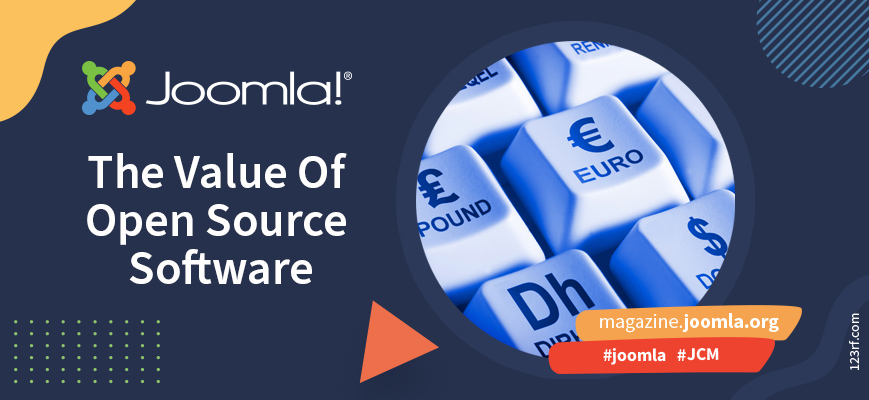The Value of Open Source Software
If your software is free for everyone to use, does that mean it isn’t worth anything? Surely not! Three researchers from Harvard Business School and the University of Toronto have found a way to estimate the value of Open Source Software. Spoiler alert: it’s nowhere near nothing.
Determining the value of a product or service is traditionally done by multiplying the price (p) times the quantity sold (q). As you probably know, Joomla is Open Source Software, free for everyone to use and download. If we use this traditional method to calculate Joomla’s value, we’d get 0 * 0. Zero, zilch, nada, nothing. So either that is what we’re worth, or we need to explore other methods. And the latter is exactly what Manuel Hoffmann and Frank Nagle (both Harvard Business School) and Yanuo Zhou (University of Toronto) did.
Open Source Software - software with a source code publicly available for inspection, use and modification, often created in a decentralized manner and distributed for free - appears in 96% of codebases.
Some commercial software consists of up to 99.9% freely available Open Sources Software. Yes, you read that correctly: people pay for software that’s almost entirely made of free stuff.
I think it’s safe to say we’re valuable. But how valuable?
Find p and q
The researchers used two primary sources to gain insights to the Open Source Software used in companies around the world: the “Census II of Free and Open Source Software - Application Libraries” (Nagle et al., 2022) and the BuiltWith dataset. The first source, the Census II project, worked together with a number of software composition analysis (SCA) firms to build a dataset of OSS usage based on millions of data points. BuiltWith provided scans of nearly nine million websites to identify the underlying technology deployed by these websites, including OSS libraries. The numbers coming from those two sources provided the most complete measurement of OSS usage to date. So there’s our q factor: it’s the usage, not the sales. But no matter what number that is, if you multiply it by zero (our price) it’s still… yes: zero, zilch, nada, nothing.
What we need is p. To estimate that, the researchers used the labor replacement value. This is how that works: you calculate the labor cost it would take an individual firm to recreate a given OSS package by measuring the number of lines of code within the package and then apply a model to find out how many person-hours it would take to write the code from scratch. Multiply that by global wage data, and you have an accurate estimate of the labor costs for this piece of Open Source Software. And there’s our p.
Numbers please!
OK, here we go. To reproduce all widely-used Open Source Software once the entire cost would be $2.59 trillion (low wage country) to $13.18 trillion (high wage country), or $8.80 trillion if we’d use programmers from across the world.
It gets interesting once you know what companies actually spend on software. That is roughly $3.4 trillion. If you combine this with what they would have to spend if they needed to pay in-house developers to write the Open Source Software they’re currently using for free, you have your number: $12.2 trillion. (3.4 plus 8.8). And that, my friends, is three and a half times what they’re actually spending on software. Imagine what budgets would look like if every organization had costs like that.
And what can I do with this intel?
Well, for one, if you’re a number nerd, you could dive into Joomla’s figures and write an article about those. Since you love numbers, here’s yours: 500 words would be great.
If you have clients who need to be convinced to use Open Source Software, impress them with the numbers from the study. They probably haven’t looked at it that way, so you’ll give them valuable insights and they’ll love you for it.
If you can’t believe everything I wrote above, you could check the study yourself and write a more accurate article (I’m only human, and terrible with numbers).
The true value of Joomla
But the true value of Joomla? If you know me at all, you should have seen this coming: it’s not q * p, it's you and me (did you notice "p and q" rhymes with "me and you"? Everything is poetry).
We’re the people creating it, working with it, maintaining it, improving it and telling the world about it. I've said it many times before and I'm going to say it again now: thank you for being valuable.
Find the paper, 42 (!) pages, with all the numbers here: https://papers.ssrn.com/sol3/papers.cfm?abstract_id=4693148
Some articles published on the Joomla Community Magazine represent the personal opinion or experience of the Author on the specific topic and might not be aligned to the official position of the Joomla Project
By accepting you will be accessing a service provided by a third-party external to https://magazine.joomla.org/
 Community Magazine
Community Magazine 
Comments